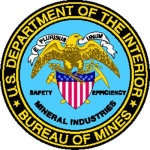- Branche: Mining
- Number of terms: 33118
- Number of blossaries: 0
- Company Profile:
The U.S. Bureau of Mines (USBM) was the primary United States Government agency conducting scientific research and disseminating information on the extraction, processing, use, and conservation of mineral resources.
Founded on May 16, 1910, through the Organic Act (Public Law 179), USBM's missions ...
A deep-red or ruby-colored variety of pyrope garnet of igneous origin, Southwestern United States.
Industry:Mining
A deep-red to light orange-yellow variety of amber having a high content of sulfur and oxygen and a low content of succinic acid; occurs in the waters off Sicily.
Industry:Mining
A deep-sea deposit, resembling flour when dry, largely composed of the frustules of diatoms and containing a small but variable proportion of calcareous organisms and mineral particles.
Industry:Mining
A deep-sea pelagic sediment containing at least 30% calcareous skeletal remains; e.g., pteropod ooze. Compare: siliceous ooze.
Industry:Mining
A deep-sea terrigenous deposit characterized by the presence of a considerable proportion of glauconite and CaCO<sub>3</sub>in variable amounts up to 50%.
Industry:Mining
A deep-seated igneous rock consisting of alkali feldspar with less than 3% dark minerals. Feldspar, both orthoclase and albite, may be perthitically intergrown as cryptoperthite or as anorthoclase.
Industry:Mining
A defect common to almost all metal ingots in which metal crystals (dendrites) tend to grow at right angles to the walls of the mold and form planes of weakness at their junctions; these make the ingot tender and it tends to tear apart when rolled.
Industry:Mining
A deflagrating or low-explosive granular compound of sulfur, charcoal, and an alkali nitrate, usually potassium or sodium nitrate.
Industry:Mining
